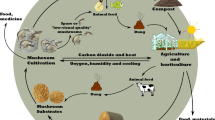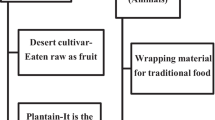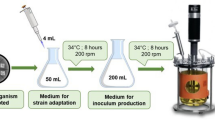Abstract
Volvariella volvacea is one of the world-famous edible mushroom varieties cultivated in lignocellulosic agricultural waste as a growth media. The present study aimed to investigate the growth and characteristics of V. volvacea and analyze the difference between the V. volvacea production yield using pineapple leaves medium compared to the oil palm empty fruit bunch (EFB) medium. The biochemical analysis of the substrate was conducted to estimate the substrate’s moisture percentage, crude fiber, ash content, and mineral content. The study results revealed that the type of substrate significantly (P < 0.05) affected the mycelial growth, moisture content, and yield of V. volvacea. The fastest growth of mycelium was exhibited on pineapple leaves substrate with mycelium invasion within 3 days. Pineapple leaves also have the highest fruiting body formation diameter (2.57 cm) and moisture content (91.61%). However, there were no significant differences (P > 0.05) observed in other parameters, including cap diameter and stipe length, weight, and biological efficiency (BE) of V. volvacea. In summary, the results demonstrate the possible expenditure of pineapple leaves to cultivate V. volvacea, which would provide a protein-rich food source and help farmers grow V. volvacea with the biological conversion processes of agro-industrial wastes.
Graphical Abstract






Similar content being viewed by others
Data availability
Inquiries about data availability should be directed to the authors.
Data Availability
All data generated or analyzed during this study are included in this published article.
References
Kumla J, Suwannarach N, Sujarit K, Penkhrue W, Kakumyan P, Jatuwong K, Vadthanarat S, Lumyong S (2020) Cultivation of mushrooms and their lignocellulolytic enzyme production through the utilization of agro-industrial waste. Molecules 25(12):2811. https://doi.org/10.3390/molecules25122811
Subbiah KA, Balan V (2015) A comprehensive review of tropical milky white mushroom (Calocybe indica P&C). Mycobiology 43(3):184–194. https://doi.org/10.5941/MYCO.2015.43.3.184
Gupta S, Summuna B, Gupta M, Annepu SK (2018) Edible mushrooms: cultivation, bioactive molecules, and health benefits. In: Mérillon JM, Ramawat K (eds) Bioactive Molecules in Food. Reference Series in Phytochemistry. Springer, Cham. https://doi.org/10.1007/978-3-319-54528-8_86-1
Rathore H, Prasad S, Sharma S (2017) Mushroom nutraceuticals for improved nutrition and better human health: a review. PharmaNutrition 5(2):35–46. https://doi.org/10.1016/j.phanu.2017.02.001
Ajikah LB, Abasi MA, Sanni RO, Walter OJ (2019) Assessing the growth performance of Volvariella volvaceae on local homemade substrate. Int J Recent Innov Acad Res 3(6):108–115 www.ijriar.com
Munir N, Xiang TC, Bhuyar P, Ramli ANM (2021) Effective microbes (EM) and their potential on mushroom commercialization in Malaysia. Maejo Int J Energy Environ Commun 3(3):45–55. https://doi.org/10.54279/mijeec.v3i3.246955
Sadh PK, Duhan S, Duhan JS (2018) Agro-industrial wastes and their utilization using solid state fermentation: a review. Bioresour Bioprocess 5(1):1–15. https://doi.org/10.1186/s40643-017-0187-z
Ravindran R, Jaiswal AK (2016) Exploitation of food industry waste for high-value products. Trends Biotechnol 34(1):58–69. https://doi.org/10.1016/j.tibtech.2015.10.008
Julien JC, Bravo-Ureta BE, Rada NE (2019) Assessing farm performance by size in Malawi, Tanzania, and Uganda. Food Policy 84:153–164
Beetz A, Kustudie M (2004) Mushroom cultivation and marketing. In: Horticulure Production Guide. ATTRA
Tripathy A (2010) Yield evaluation of paddy straw mushrooms (Volvariella spp.) on various lignocellulosic wastes. Int J Appl Agric Res 5(3):317–326 http://www.ripublication.com/ijaar.htm
Sakinah NM, Misran A, Mahmud TMM, Abdullah S (2019) A review: production and postharvest management of Volvariella volvacea. Int Food Res J 26(2):367–376
Thiribhuvanamala G, Krishnamoorthy S, Manoranjitham K, Praksasm V, Krishnan S (2012) Improved techniques to enhance the yield of paddy straw mushroom (Volvariella volvacea) for commercial cultivation. Afr J Biotechnol 11(64):12740–12748. https://doi.org/10.5897/AJB11.4066
Triyono S, Haryanto A, Telaumbanua M, Dermiyati, Lumbanraja J, To F (2019) Cultivation of straw mushroom (Volvariella volvacea) on oil palm empty fruit bunch growth medium. Int J Recycl Org Waste Agric 8(4):381–392. https://doi.org/10.1007/s40093-019-0259-5
Philippoussis A, Zervakis G, Diamantopoulou P (2001) Bioconversion of agricultural lignocellulosic wastes through the cultivation of the edible mushrooms Agrocybe aegerita, Volvariella volvacea and Pleurotus spp. World J Microbiol Biotechnol 17(2):191–200. https://doi.org/10.1023/A:1016685530312
Rajapakse P (2011) New cultivation technology for paddy straw mushroom (Volvariella volvacea). In: International Conference on Mushroom Biology and Mushroom Products (ICMBMP7), 7th (January 2011), pp 446–451
Ramli ANM, Hamid HA, Zulkifli FH, Zamri N, Bhuyar P, Manas NHA (2021) Physicochemical properties and tenderness analysis of bovine meat using proteolytic enzymes extracted from pineapple (Ananas comosus) and jackfruit (Artocarpus heterophyllus) by-products. J Food Process Preserv 45(11):e15939. https://doi.org/10.1111/jfpp.15939
Narh Mensah DL, Addo P, Dzomeku M, Obodai M (2018) Bioprospecting of powdered pineapple rind as an organic supplement of composted sawdust for Pleurotus ostreatus mushroom cultivation. Food Sci Nutr 6(2):280–286. https://doi.org/10.1002/fsn3.551
Fam SF, Laham J, Sapak Z, Chuan ZL, Ahamat A, Zin WZW, Suhartono (2019) Factors influencing Malaysian pineapple small-holders intention to adopt MyGAP and MPIB roles to inspire the growers to obtain MyGAP certification. Hum Soc Sci Rev 7(2):315–321. https://doi.org/10.18510/hssr.2019.7237
Nigam PSN, Pandey A (2009) Biotechnology for agro-industrial residues utilization: utilization of agro-residues. In: In Biotechnology for Agro-Industrial Residues Utilisation: Utilization of Agro-Residues (Issue March). Springer Science & Business Media. https://doi.org/10.1007/978-1-4020-9942-7
Girmay Z, Gorems W, Birhanu G, Zewdie S (2016) Growth and yield performance of Pleurotus ostreatus (Jacq. Fr.) Kumm (oyster mushroom) on different substrates. Amb Express 6(1):1–7. https://doi.org/10.1186/s13568-016-0265-1
Rupasinghe K, Nandasena K (2006) Potential exploitation of refuse tea as an alternative medium in mushroom cultivation. Tropical Agricultural Research
Salit RB, Shea YR, Gea-Banacloche J, Fahle GA, Abu-Asab M, Sugui JA, Carpenter AE, Quezado MM, Bishop MR, Kwon-Chung KJ (2010) Death by edible mushroom: first report of Volvariella volvacea as an etiologic agent of invasive disease in a patient following double umbilical cord blood transplantation. J Clin Microbiol 48(11):4329–4332
Carrasco J, Zied DC, Pardo JE, Preston GM, Pardo-Giménez A (2018) Supplementation in mushroom crops and its impact on yield and quality. AMB Express 8(1):1–9. https://doi.org/10.1186/s13568-018-0678-0
Taylor JW, Ellison CE (2010) Mushrooms: morphological complexity in the fungi. Proc Natl Acad Sci 107(26):11655–11656. https://doi.org/10.1073/pnas.1006430107
Zainuddin MF, Shamsudin R, Mokhtar MN, Ismail D (2014) Physicochemical properties of pineapple plant waste fibers from the leaves and stems of different varieties. BioResources 9(3):5311–5324
Hemalatha R, Anbuselvi S (2013) Physicohemical constituents of pineapple pulp and waste. J Chem Pharm Res 5(2):240–242
Vos AM, Jurak E, Pelkmans JF, Herman K, Pels G, Baars JJ, Hendriz E, Kabel MA, Lugones LG, Wösten HA (2017) H2O2 as a candidate bottleneck for MnP activity during cultivation of Agaricus bisporus in compost. Amb Express 7(1):1–9. https://doi.org/10.1186/s13568-017-0424-z
Kortei NK, Odamtten GT, Obodai M, Wiafe-Kwagyan M, Mensah DLN (2018) Correlations of cap diameter (pileus width), stipe length and biological efficiency of Pleurotus ostreatus (Ex. Fr.) Kummer cultivated on gamma-irradiated and steam-sterilized composted sawdust as an index of quality for pricing. Agric Food Secur 7(1):1–8. https://doi.org/10.1186/s40066-018-0185-1
Chukwurah NF, Eze SC, Chiejina NV, Onyeonagu CC, Okezie CEA, Ugwuoke KI, Ugwu FSO, Aruah CB, Akobueze EU, Nkwonta CG (2013) Correlation of stipe length, pileus width and stipe girth of oyster mushroom (Pleurotus ostreatus) grown in different farm substrates. J Agric Biotechnol Sustain Dev 5(3):54–60. https://doi.org/10.5897/JABSD12.20
Engin D (2019) Effect of drying temperature on colour and desorption characteristics of oyster mushroom. Food Sci Technol 40:187–193. https://doi.org/10.1590/fst.37118
Nadirah WW, Jawaid M, Al Masri AA, Khalil HA, Suhaily SS, Mohamed AR (2012) Cell wall morphology, chemical and thermal analysis of cultivated pineapple leaf fibres for industrial applications. J Polym Environ 20(2):404–411
Chen A, Guan YJ, Bustamante M, Uribe L, Uribe-Lorío L, Roos MM, Liu Y (2020) Production of renewable fuel and value-added bioproducts using pineapple leaves in Costa Rica. Biomass Bioenergy 141:105675. https://doi.org/10.1016/j.biombioe.2020.105675
Chaurasiya RS, Hebbar HU (2013) Extraction of bromelain from pineapple core and purification by RME and precipitation methods. Sep Purif Technol 111:90–97. https://doi.org/10.1016/j.seppur.2013.03.029
Carlin TM, Finch N, Khairi KF (2010) FRS36 and post-transition compliance quality among Singapore firms. Asian Rev Account 18(3):221–244. https://doi.org/10.1108/13217341011089630
Kizilel R, Lateef A, Sabbah R, Farid MM, Selman JR, Al-Hallaj S (2008) Passive control of temperature excursion and uniformity in high-energy Li-ion battery packs at high current and ambient temperature. J Power Sources 183(1):370–375. https://doi.org/10.1016/j.jpowsour.2008.04.050
Lateef A, Oloke JK, Gueguim Kana EB, Oyeniyi SO, Onifade OR, Oyeleye AO, Oladosu OC, Oyelami AO (2008) Improving the quality of agro-wastes by solid-state fermentation: enhanced antioxidant activities and nutritional qualities. World J Microbiol Biotechnol 24(10):2369–2374. https://doi.org/10.1007/s11274-008-9749-8
Chang ST, Miles PG (2004) Mushrooms: Cultivation, nutritional value, medicinal effect, and environmental impact. In: Mushrooms: Cultivation, Nutritional Value, Medicinal Effect, and Environmental Impact, 2nd edn. CRC press. https://doi.org/10.1663/0013-0001(2005)059[0310:dfabre]2.0.co;2
Sales-Campos C, da Eira AF, de Almeida Minhoni MT, de Andrade MCN (2009) Mineral composition of raw material, substrate, and fruiting bodies of Pleurotus ostreatus in culture. Interciencia 34(6):432–436
Marschner H (2002) Functions of mineral nutrients: micronutrients. In: Marschner’s Mineral Nutrition of Higher Plants. https://doi.org/10.1016/b978-0-08-057187-4.50015-1
Haq IU, Ijaz S, Khan NA, Amrao L (2017) Comparative study on the growth of exotic and local strains of Volvariella volvacea fungus on different substrates. Pakistan J Phytopathol 29(2):227–232
Zikriyani H, Saskiawan I, Mangunwardoyo W (2018) Utilization of agricultural waste for cultivation of paddy straw mushrooms (Volvariella volvacea (Bull.) Singer 1951). Int J Agric Technol 14(5):805–814
Maurya AK, Kumar P, Singh V, Kumar S (2016) Evaluation of substrates and supplements for enhancing the productivity of paddy straw mushroom (Volvariella volvacea). Res Environ Life Sci 9(6):717–720
Okhuoya JA, Akpaja EO, Oghenekaro A (2005) Cultivation of Lentinus squarrosulus (Mont.) Singer on sawdust of selected tropical tree species. Int J Med Mushrooms 7(3):213–218. https://doi.org/10.1615/IntJMedMushrooms.v7.i3.790
Akinyele BJ, Adetuyi FC (2005) Effect of agrowastes, pH and temperature variation on the growth of Volvariella volvacea. Afr J Biotechnol 4(12). https://www.ajol.info/index.php/ajb/article/view/71438/60384
Mamimin C, Chanthong S, Leamdum C, Sompong O, Prasertsan P (2021) Improvement of empty palm fruit bunches biodegradability and biogas production by integrating the straw mushroom cultivation as a pretreatment in the solid-state anaerobic digestion. Bioresour Technol 319:124227. https://doi.org/10.1016/j.biortech.2020.124227
Hou L, Li Y, Chen M, Li Z (2017) Improved fruiting of the straw mushroom (Volvariella volvacea) on cotton waste supplemented with sodium acetate. Appl Microbiol Biotechnol 101(23):8533–8541. https://doi.org/10.1007/s00253-017-8476-1
Arce-Cervantes O, Saucedo-García M, Lara HL, Ramírez-Carrillo R, Cruz-Sosa F, Loera O (2015) Alternative supplements for Agaricus bisporus production and the response on lignocellulolytic enzymes. Sci Hortic 192:375–380. https://doi.org/10.1016/j.scienta.2015.06.030
Kamthan R, Tiwari I (2017) Agricultural wastes-potential substrates for mushroom cultivation. Eur J Exp Biol 7(5):3–6. https://doi.org/10.21767/2248-9215.100031
Brinda GB, Thara SS (2018) Variability of paddy straw mushroom collections from southern Kerala. J Trop Agric 56(1). http://www.jtropag.kau.in/index.php/ojs2/article/view/605/458
Thuc LV, Corales RG, Sajor JT, Thi N, Truc T, Hien PH, Ramos RE, Bautista E, Tado CJM, Ompad V, Son DT (2020) Sustainable rice straw management. sustainable rice straw management. https://doi.org/10.1007/978-3-030-32373-8
Nurudeen TA, Ekpo EN, Olasupo OO, Haastrup NO (2013) Yield and proximate composition of oyster mushroom (Pleurotus sajor-caju) cultivated on different agricultural wastes. Sci J Biotechnol 2013:sjbt-189
Li H, He Z, Jiang Y, Kan J, Peng T, Zhong M, Hu Z (2020) Bioconversion of bamboo shoot shells through the cultivation of the edible mushrooms Volvariella volvacea. Ecotoxicology 30:1476–1486. https://doi.org/10.1007/s10646-020-02281-6
Nout MJR, Keya SO (1983) Cultivation of Pleurotus sajor-caju in Kenya. Mush Newslett Trop 4.2(1983):12–15
Nasir IN, Siva R (2019) Mycochemical composition of straw paddy mushroom (Volvariella volvacea) grown on used palm oil bunch. J Sustain Sci Manag 14(6):12–21
Zhao M, Zhang Z, Cai H, Wang L, Hu C, Li D, Chen Y, Kang Y, Li L (2022) Controlled moisture permeability of thermoplastic starch/polylactic acid/poly butylene adipate-co-terephthalate film for the autolysis of straw mushroom Volvariella volvacea. Food Chem 373:131409
Zhao P, Ndayambaje JP, Liu X, Xia X (2022) Microbial spoilage of fruits: a review on causes and prevention methods. Food Rev Intl 38(sup1):225–246
Quinio TH, Chang ST, Royce DJ (1990) Technical guidelines for mushroom growing in the tropics. FAO plant production and protection paper, Rome, p 65
Acknowledgements
The authors gratefully acknowledged Universiti Malaysia Pahang for the financial assistance through Research Grant No. PDU223211.
Funding
This work was supported by the Universiti Malaysia Pahang (UMP) under the Research Grant No. PDU223211.
Author information
Authors and Affiliations
Corresponding author
Ethics declarations
Conflict of interest
The authors declare no competing interests.
Additional information
Publisher’s note
Springer Nature remains neutral with regard to jurisdictional claims in published maps and institutional affiliations.
Rights and permissions
Springer Nature or its licensor (e.g. a society or other partner) holds exclusive rights to this article under a publishing agreement with the author(s) or other rightsholder(s); author self-archiving of the accepted manuscript version of this article is solely governed by the terms of such publishing agreement and applicable law.
About this article
Cite this article
Munir, N., Ramli, A.N.M., Norsazali, N.F.S. et al. Valorization of agro-industrial waste for the advancement of mushrooms and their production yield. Biomass Conv. Bioref. (2023). https://doi.org/10.1007/s13399-023-04773-x
Received:
Revised:
Accepted:
Published:
DOI: https://doi.org/10.1007/s13399-023-04773-x




